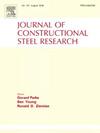Steel reuse for sustainable design of large-span structures: The case of gridshells
IF 4
2区 工程技术
Q1 CONSTRUCTION & BUILDING TECHNOLOGY
引用次数: 0
Abstract
Gridshells are lightweight spatial structures widely used for large-span constructions, offering high structural efficiency with minimal material usage. A key challenge in their sustainable design is integrating reclaimed steel elements to reduce environmental impact while maintaining structural performance. This study addresses this challenge by developing a stock-constrained optimization method, tested within the FreeGrid benchmark (https://sites.google.com/view/freegrid/home), to maximize the reuse of steel members while ensuring mechanical feasibility. A barrel vault gridshell is used as a case study with different grid configurations. The global performance is evaluated using three performance metrics, accounting for structural response, sustainability, and buildability. Due to the computational complexity of nonlinear analyses, a simplified method based on the Merchant-Rankine formula is introduced to estimate structural performance. The optimal solutions incorporating reused elements (ReBGs) are subsequently validated through geometrically and materially nonlinear analysis (GMNA) to verify their reliability. The results demonstrate that gridshells incorporating reclaimed steel achieve greater sustainability performance compared to conventional designs (BGs) while maintaining good structural performance. However, the irregular geometries generated during optimization negatively affect buildability, emphasizing the need for additional constraints in future developments. This study highlights that integrating reclaimed steel into gridshell design within the FreeGrid framework can effectively reduce environmental impact while ensuring structural efficiency, paving the way for broader applications in sustainable construction.
大跨度结构可持续设计中的钢材再利用:以格壳为例
网壳结构是一种广泛应用于大跨度结构的轻型空间结构,以最小的材料用量提供了较高的结构效率。可持续设计的一个关键挑战是整合再生钢元素,以减少对环境的影响,同时保持结构性能。本研究通过开发库存约束优化方法解决了这一挑战,并在FreeGrid基准(https://sites.google.com/view/freegrid/home)中进行了测试,以最大限度地重复使用钢构件,同时确保机械可行性。以桶顶网格壳为例,对不同网格结构进行了分析。使用三个性能指标来评估全球性能,即结构响应、可持续性和可建造性。考虑到非线性分析的计算复杂性,提出了一种基于Merchant-Rankine公式的结构性能估计简化方法。随后,通过几何和材料非线性分析(GMNA)验证了包含重用元件(rebg)的最优解决方案的可靠性。结果表明,与传统设计(bg)相比,采用再生钢的网格壳在保持良好结构性能的同时,具有更高的可持续性性能。然而,在优化过程中产生的不规则几何形状会对可建造性产生负面影响,这强调了在未来的开发中需要额外的限制。这项研究强调,在FreeGrid框架内将再生钢整合到网格壳设计中可以有效地减少对环境的影响,同时确保结构效率,为可持续建筑的更广泛应用铺平道路。
本文章由计算机程序翻译,如有差异,请以英文原文为准。
求助全文
约1分钟内获得全文
求助全文
来源期刊

Journal of Constructional Steel Research
工程技术-工程:土木
CiteScore
7.90
自引率
19.50%
发文量
550
审稿时长
46 days
期刊介绍:
The Journal of Constructional Steel Research provides an international forum for the presentation and discussion of the latest developments in structural steel research and their applications. It is aimed not only at researchers but also at those likely to be most affected by research results, i.e. designers and fabricators. Original papers of a high standard dealing with all aspects of steel research including theoretical and experimental research on elements, assemblages, connection and material properties are considered for publication.
 求助内容:
求助内容: 应助结果提醒方式:
应助结果提醒方式:


